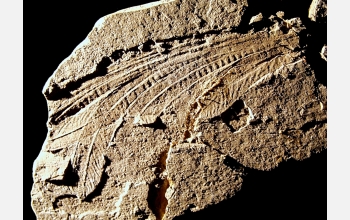Multimedia Gallery
Longisquama insignis Fossil
This 220-million-year-old fossil offers evidence that dinosaurs were not ancestral to birds.
More about this Image
An archosaur called Longisquama insignis, a small reptile roughly the size of a mouse, has ignited scientific controversy due to the six, vane-like appendages attached to either side of Longisquama's back. Longisquama's lived about 220 million years ago in Asia, during the late Triassic era. Some researchers believe the appendages were non-avian feathers and that early archosaurs were the ancestors of modern birds. Longisquama is controversial because it's not a dinosaur and most paleontologists believe that birds evolved from dinosaurs.
In 1999, a team of scientists who studied the fossil found arresting parallels between the appendages and feathers, most notably, a hollow shaft with a sheath characteristic of modern feathers. Some scientists believe this shows that the genetic and developmental potential to produce feathers was present in these early archosaurs. The team also reached the conclusion that the feathers weren't used for thermoregulation but likely allowed the creature to glide between trees.
However, many scientists believe that features as specialized as feathers had only one path of evolution so if feathers evolved from Longisquama's, which occupies one branch of the archosaur family (a subclass of reptiles), they are unlikely also to have evolved in another archosaur, like theropods. Paleontologists who do believe that birds evolved from theropod dinosaurs cite skeletal similarities to back up their claim. The team's findings were reported in the June 23, 2000, issue of Science.
Credit: Oregon State University
See other images like this on your iPhone or iPad download NSF Science Zone on the Apple App Store.
Images and other media in the National Science Foundation Multimedia Gallery are available for use in print and electronic material by NSF employees, members of the media, university staff, teachers and the general public. All media in the gallery are intended for personal, educational and nonprofit/non-commercial use only.
Images credited to the National Science Foundation, a federal agency, are in the public domain. The images were created by employees of the United States Government as part of their official duties or prepared by contractors as "works for hire" for NSF. You may freely use NSF-credited images and, at your discretion, credit NSF with a "Courtesy: National Science Foundation" notation.
Additional information about general usage can be found in Conditions.
Also Available:
Download the high-resolution JPG version of the image. (1.3 MB)
Use your mouse to right-click (Mac users may need to Ctrl-click) the link above and choose the option that will save the file or target to your computer.



